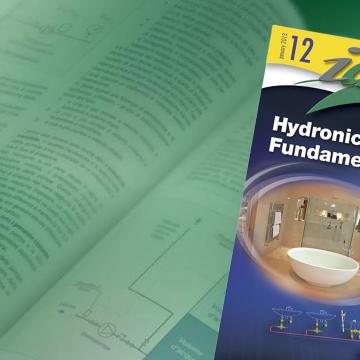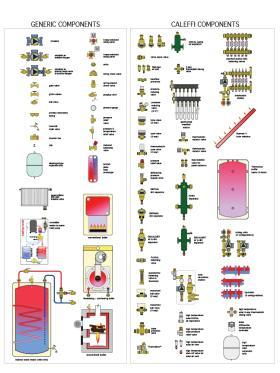APPENDIX A
APPENDIX B
The size of the buffer tank used in a system is determined by the desired “on-time” of the heat source and the acceptable temperature rise of the water in the buffer tank during this on-time. The on-time is that time between when the heat source turns on to begin warming the tank and when it turns off after lifting the tank temperature through the acceptable temperature rise. Formula B-1 can be used to determine tank size.
$$ V_{btank} = {t(Q_{HP} - Q_L) \over 500(\Delta T)} $$
where:
$V_{btank}$ = required volume of buffer tank (gallons)
$t$= desired on-time for heat source (minutes)
$Q_{HP}$ = heating output of heat source (Btu/hr)
$Q_L$ = heating output of heat source (Btu/hr) QL = any heating load served by buffer tank while charging (Btu/hr)
$\Delta T$= allowed temperature rise of tank during heat source on-time (ºF)
Example: Determine the size of a buffer tank that will absorb 48,000 Btu/hr while increasing in temperature from 90ºF to 110ºF during a heat source on-cycle of 10 minutes. There is no heating load on the tank during this charging.
Solution: The temperature rise (∆T) is 110-90 = 20ºF. Putting this and the remaining data into Formula B-1 yields:
$$ V_{btank} = {t(Q_{HP} - Q_L) \over 500(\Delta T)} = {10(48000- 0) \over 500(20)} = 48\ gallons$$
If the allowed temperature rise was 10ºF, rather than 20ºF, the required tank volume would double to 96 gallons. If the desired on-time was only 5 minutes rather than 10 minutes, the volume would be cut in half. Anything that increases the desired on-time or decreases the allowed temperature rise during this on-time will increase the required tank volume, and vice versa.
The same formula can be used to determine the size of a buffer tank used for cooling. The value of QHP would be the cooling capacity of the heat pump. The value of ∆T would be the allowed temperature drop in the tank during this on-time.


